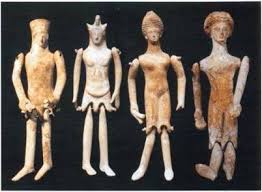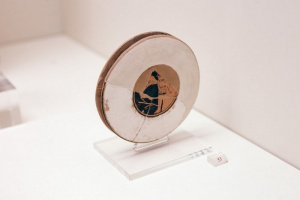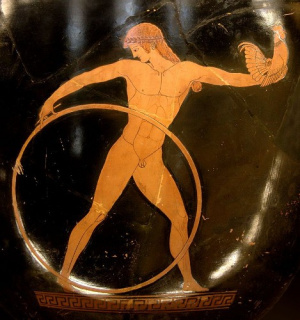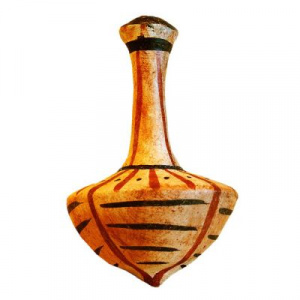Language/Modern-greek-1453/Culture/Toys-and-Games-in-Ancient-Greece
Ancient Greek Toys
English
Many of the toys that Greek children enjoyed thousands of years ... juggling, balancing sticks, and playing on the seesaw, can still be seen on playgrounds.
Many of the toys and games we play today, like dolls, the yoyo, jacks, ball, blind man’s buff, hopscotch, hide-and-seek, and statues, resemble the toys and games of antiquity—only the names differ.Through descriptions, illustrations, and images of ancient toys, now in Greek and foreign museums, the reader learns about the toys and games enjoyed in ancient Greece. The toys for the Greeks indicating the importance that it had in their lives.
The play was an integral part of Greek childhood – a time when they learned to socialize with friend and family and when gender stereotyping was reinforced. The kids in Greek had a number of Ancient Greek toys to play with, in their pastime. Dolls, rattles, tops, swings, and many other items
have been unearthed by archaeologists.
| Dolls
Clay "Plaggona"(dolls) with movable limbs, 4th and 5th century B.C. Plaggonas were the favorite toys of girls and those with movable limbs were played with like the dolls of today. They dressed them in clothes sewn for the purpose by the women of the house. Besides being fun, the dolls introduced the young female population to their destined roles: to be good husbands, housewives, and mothers of healthy children. Girls dedicated the "Plaggonas", along with other toys and a hairpin, on the eve of their wedding to Artemis, the protector of every transitional stage of human life and the procreation of children in androgynes, and to Aphrodite, goddess of love and fertility. | |
| | | Boeotian red-shaped spool (yo-yo)
Greek FirstsThe Ancient Greeks were the first to create a toy like the yo-yo we know today. It was made with discs of clay, joined in the middle by a cylindrical shaft to which they attach the beginning of a thread, which is then wound around it. If the thread is dropped, it unfolds while it is collected around the shaft again with a hand movement. Perseus is depicted on one side and Medusa on the other. From Kaverio of Thebes, 425-400 B.C |
| Hoop rolling - Krikilassia
It was a popular form of recreation for young and old. Besides children’s game, hoop rolling (trochus) was practiced by men in palaestra as a training exercise. Hoops were made of metals, like bronze, iron or copper. Greek pottery representations usually show boys rolling a hoop with a stick. | |
| Spinning tops – Strombos : σβούρα
Another skill toy was the “strombos”, that is, our modern tops. There were many variations of spinning tops, with lots of different shapes and colours. The easiest way to play was to try turning the top with your hand. In another variation, the player used to spin it with the help of a small whip, as we can see in this Greek vase from the 5th century BCE. Spinning tops were a favourite toy with boys and girls. There were two types: the twirler and the whipping top.The twirler had a stem on the top to get it spinning by hand. Most spinning tops were made of wood or terracotta. | |
| Dice - Pessoi
The Greek referred to the dice as the “pessoi”, and as today’s dice, they were cubes with marked sides, numbered from 1 to six. Dice, along with knuckle-bones, were used as part of board games and games of chance. As games of chance they were played especially by men. Games were not limited only to children. Adults in Greece loved their games as well. The Greeks apparently had a love of gambling, and have invented dice.Their dice were like ours. They were small cubes with the numbers positioned so that the ones on opposite sides added up to seven. But unlike modern dice, ancient Greek dice were usually made of ivory or bone. | |
| Baby Rattle - Platagi
Seistron (σείστρο) or platagi ancient percussion instrument, made of wood, metal, clay or acombination of all, the rattle it was the first toy given to children and newborns, since the sound it made when they shook it stopped them from crying. It was also believed that the sound of the rattle kept away the evil spirits that lay around a baby’s cradle. According to Plato, educational toys help children to better prepare for their future profession and their role in society. “And by the use of games one shall strive to turn the tastes and the desires of children to the goal they are to attain in adulthood.” | |
| Greek Episkyros (Ball Game)- Sphere
Episkyros was an ancient Greek ball sport with some coincidental similarities to American football. The sport involved attempting to move a ball past the opposing team’s end of the field, keeping it away from the other team by passing from player to player while avoiding tackles. It had a reputation of violence, though, ot all of the details of the sport can be made out in full due to its somewhat scarce records, though historians have been able to piece together some of its primary features. | |
| Greek toy swingsets - Aeora
Ancient Greek children even had swingsets, as this clay model shows. Probably the swingsets and the swings were made of wood, with hemp ropes for the swings. The little model was also probably a toy swingset, with a little clay doll that swings on it. Probably made in a small factory and sold in a toystore for parents to give their children. | |
| Tug of war – Dielkystinda
Dielkystinda was an Olympic game in the new Olympic games but it weakened little by little and they are thinking of bringing it back.There are references to this game into the ancient Greek written tradition, in Homer, Theaetetos etc.The game was played until a few years ago, in schools and playgrounds in many variations, in an upright position, or with one foot forward, half sited, full sited etc. | |
| Hide-and-seek - Apodidraskinda
Hide-and-seek , old and popular children’s game in which one player closes his or her eyes for a brief period, often counting while the other players hide. | |
| The game leapfrogging - Moskinda
The game is leapfrogging is a children's game in which players vault over each other's stooped backs. The first child should crouch down and rest their hands on their knees. The second player runs up to the crouched child in front, placing their hands on their back and leaping over straddling their legs wide apart on each side. |
**These are the toys and games the most interesting. Naturally there are others, no less fascinating, that resist time and technological advances and continue to fill children with joy thousands of years later.
Τα παιχνίδια στην Αρχαία Ελλάδα
Οι αρχαίοι Έλληνες πίστευαν ότι το παιχνίδι, κυρίως το ομαδικό, βοηθάει τα παιδιά στις δυσκολίες και τα προβλήματά τους. Αναπτύσσει τη συντροφικότητα, ασκεί το σώμα, καλλιεργεί το πνεύμα.
Μαθαίνει τα παιδιά να σέβονται τους κανόνες του παιχνιδιού και έτσι να σέβονται και να τηρούν τους νόμους της πατρίδας. Μπορεί με αυτό να πραγματοποιηθεί η τελειοποίηση της ανθρωπότητας.
- Τα πιο συνηθισμένα παιχνίδια Η πλαταγή Πήλινη κουδουνίστρα, που την έβαζαν στο χέρι του μωρού και με τον ήχο που έκαναν τα πετραδάκια που είχε μέσα, το έκαναν να ξεχνιέται και να σταματάει το κλάμα.
- Πλαγγόνες : Το αγαπημένο παιχνίδι των κοριτσιών. Ήταν κούκλες φτιαγμένες από πηλό ή κερί και είχαν συμβολικό χαρακτήρα. Είχαν και εκπαιδευτικό χαρακτήρα, σαν μια εισαγωγή του κοριτσιού στο ρόλο και τις υποχρεώσεις του ως γυναίκα στην κοινωνία.
- Άθυρμα :Το αγαπημένο παιχνίδι των μεγαλύτερων αγοριών. Ένα πήλινο αλογάκι πάνω σε ρόδες, που το έσερναν σε όλο το σπίτι.
- Αμαξάκι με ρόδες : Η επιθυμία των αγοριών, να δείξουν πως έχουν μεγαλώσει και να μιμούνται τους μεγάλους
- Κάλαμον περιβήναι : Συχνά τα παιδιά, όταν δεν είχαν αμαξάκι με ρόδες, κουβαλούσαν ένα καλάμι και έκαναν πως κάλπαζαν πάνω στο άλογο τους.
- Αιώρα Η γνωστή κούνια.
- Η χαλκή μυία : Ένα αγαπημένο ομαδικό παιχνίδι σαν τη σημερινή μας τυφλόμυγα.
- Η αποδιδρασκίνδα ή κρυπτίδα : το σημερινό μας κρυφτό
- Η ακινητίνδα : το σημερινό «αγαλματάκια ακούνητα, αγέλαστα κι αμίλητα».
- Ο ασκωλιασμός : Έβαζαν στη μέση ενός αλωνιού ένα φουσκωμένο ασκί, αλειμμένο απ' έξω με λάδι, για να γλιστρά.
Όσοι έπαιρναν μέρος στο παιχνίδι, έπρεπε να πάρουν φόρα ν' ανέβουν στο ασκί, να ισορροπήσουν και να χορέψουν με το ένα πόδι πάνω σ' αυτό.
11. Η σφαίρα : Η σφαίρα (μπάλα) ήταν κατασκευασμένη από αλογότριχες κι ως εξωτερικό περίβλημα είχε δέρμα
ή κομμάτια ύφασμα ραμμένα μεταξύ τους.
12. Η Διελκυστίνδα ή Σκαπέρδα : Τα παιδιά στέκονταν σε δύο αντικριστές γραμμές το ένα πίσω από το άλλο, κρατώντας ένα μεγάλο σκοινί.
13. Ο στρόβιλος ή βέμβιξ ή στρόμβος : είναι η γνωστή μας ξύλινη ή μεταλλική σβούρα. Οι στρόμβοι ήταν φτιαγμένοι από ξύλο, ορείχαλκο ή πηλό.
14 . Γιο-Γιο : Οι παίκτες σκάλιζαν σε ένα ξύλο δυο δίσκους που ενώνονταν στο κέντρο με έναν κυλινδρικό άξονα, πάνω στον οποίο
στερέωναν την αρχή μιας κλωστής την οποία στη συνέχεια τύλιγαν γύρω-γύρω .Το γιο-γιο ήταν έτοιμο. Το άφηναν να πέσει και η
κλωστή ξετυλιγόταν,ενώ με μια κίνηση του χεριού ξαναμαζευόταν γύρω από τον άξονα.
15 : Κρικηλασία: Παιγνίδι με κρίκο, τροχό σαν το σημερινό στεφάνι, το τσέρκι.
16.Το αστραγαλίζειν : Το παιχνίδι με τους αστραγάλους ή αλλιώς τα κότσια.
17 .Το ζατρίκιον : Το αρχαίο ελληνικό σκάκι.
- Ευγενική χορηγία που στοχεύει να βοηθήσει μαθητές ή μη, απανταχού της Γης, που επιδίδονται στην εκμάθηση της ελληνικής γλώσσας!
- Contribution bénévole visant à aider les personnes, partout dans le monde, qui sont engagées dans l'apprentissage de la langue grecque !
- Voluntary contribution aimed at helping people, all over the world, who are committed to learning the Greek language!




